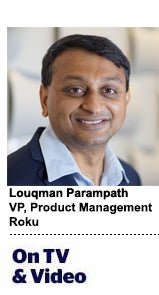“On TV & Video” is a column exploring opportunities and challenges in advanced TV and video.
Today’s column is by Louqman Parampath, VP of product management at Roku.
In 1868, consumer packaged goods entrepreneur J.R. Watkins pioneered a new advertising tactic – the money-back guarantee.
New shoppers were unsure about Watkins’s home apothecary. Buyers carried all the risk without any quality assurance. So Watkins offered a full refund for any product that did not perform as promised. The transparency helped turn a small business into a well-known personal care brand that recently celebrated its 150th anniversary.
For marketers, conveying quality through advertising has always been a challenge. Today, it’s as important as ever. But with many more platforms and devices than Watkins had to consider 150 years ago, it’s more complex than ever, too.
How can the industry capture quality in today’s TV advertising ecosystem?
Focus on what matters most
Let’s start with a definition of advertising quality – the assurance that consumers get exactly what they believe they bought. Fortunately, issues like fraud, viewability and malware that plagued the early years of digital advertising have not hurt TV streaming as much.
However, as TV advertising automates and open exchanges expand, it is important for marketers to focus on what matters most – quality – and prepare their planning now for the world ahead.
Quality includes multiple aspects. There is the quality of the content itself, like a high production value. There is also the quality of the traffic: real humans versus bots. Ultimately, the quality stems from having a direct relationship with the consumer as well as a direct relationship with the publishers and/or platforms.
Focusing on these direct relationships will result in the highest quality of advertising in TV streaming.
Champion transparent standards
Advertising quality is a team sport. The advertising industry succeeds when we create shared, transparent standards that make it easy for marketers to identify the best advertising inventory.
For instance, the IAB Tech Lab has worked to develop quality frameworks. That includes ads.txt for publishers to list their authorized resellers, sellers.json for buyers to discover who is selling advertising inventory and SupplyChain Object for marketers to see all parties selling or reselling a bid request.
Meanwhile, Omnicom Media Group has launched the Connected TV Signal Standardization Initiative with protocols to accelerate the shift in advertising spend into TV streaming. The result: When we come together around clear guidelines and technology for advertising quality, marketers can follow the consumer with confidence.
Keep consumers’ trust
The best way for brands to ensure quality is to prioritize trusted platforms and publishers. Marketers have a clear choice when buying advertising: partners with a direct consumer relationship or middlemen with no direct consumer relationship.
Trusted platforms and publishers are household brands that know their users, have a consumer tech stack and privacy policy and provide support when consumers have a question. Middlemen collect data with logins and IDs that most consumers don’t understand. They use consortiums to pass data across various partners, putting consumers’ trust in jeopardy.
Leading brands cannot afford to risk quality with partners who have not built trust through direct consumer relationships. Brands must believe in standards by design. Together, we have a tremendous, industrywide opportunity to build today for a future of advertising quality tomorrow.
Follow Roku (@Roku) and AdExchanger (@adexchanger) on Twitter.












